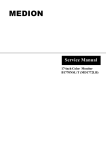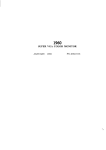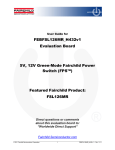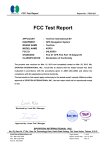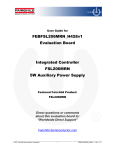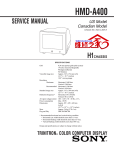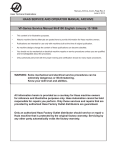Download Medion B1997PNST Service manual
Transcript
R Service Manual 19-inch Color Monitor B1997PNST (MD 1998LE) Service Manual Versions and Revision N o. 1. Ve rs ion R e le as e D ate R e vis ion 1.0 N ov. 21, 2000 O riginal release Copyright Trademarks Copyright 2000 LiteOn Technology Corp. LiteOn is a registered trademark of LiteOn Technology Corp. All Rights Reserved This manual may not, in whole or in part, be copied, photocopied, reproduced, translated, or converted to any electronic or machine readable form without prior written permission of LiteOn Technology Corp. MD 1998LE (B1997PNST) Service Manual. Printed in Taiwan. All other trademarks are the property of their respective owners. MD 1998LE (B1997PNST) Table of Contents 1. Precautions.........................................................................................................2 2. Product Specifications .......................................................................................5 3. Operation Theory................................................................................................9 4. Alignments and Adjustments ........................................................................... 14 5. Troubleshooting ............................................................................................... 18 6. Recommended Spare Parts List ....................................................................... 22 7. Block Diagram ................................................................................................ 24 8. Exploded Diagrams.................................................................................. Inserted 9. PCB Diagrams ......................................................................................... Inserted 10. Schematic Diagrams ................................................................................ Inserted Page 1 MD 1998LE (B1997PNST) 1 Precautions Please follow these safety and servicing precautions to prevent damage and to protect against potential hazards such as electrical shock and X-rays. 1-1 Safety Precautions 1-1-1 Warnings 1. For safety purpose, do not attempt to modify the circuit board, and always disconnect the AC power before performing servicing on the monitor. 2. Operation of the monitor outside its cabinet or with the cover removed involves the risk of shock hazard. Repair work on the monitor should only be attempted by service personnel who are thoroughly familiar with all necessary safety precautions and procedures for working on high voltage equipment. 3. Do not lift the CRT by the neck. After completely discharging the high voltage anode, handle the CRT only when wearing shatterproof goggles. Try to keep the CRT away from the body during handling. 4. High voltage should always be kept at the rated value, no higher. Only when high voltage is excessive are X-rays capable of penetrating the shell of the CRT. Operation at high voltages may also cause failure of the CRT or high voltage circuitry. 5. The CRT is especially constructed to limit Xray emission to 0.5mR/HR at 300 microamperes anode current. To ensure continued X-ray protection, replace the CRT with only the same or equivalent type as the original, and adjust the anode’s voltage to the designated maximum rating, never to exceed. nonmetallic control knobs, insulating materials, cabinet backs, adjustment and compartment covers or shields, isolation resistor-capacitor networks, mechanical insulators, etc. 3. AC Leakage Current Check Always perform the AC Leakage Current Check on the exposed metal parts, including metal cabinets, screwheads and control shafts, as follows: a) Plug the AC line cord directly into a rated AC outlet. Do not use an isolation transformer during the check. b) Use an AC voltmeter with at least 5000 ohms per volt sensitivity as follows: Connect a 1500 ohms, 10 watt resistor paralleled by a 0.15uF AC capacitor in series with all exposed metal cabinet parts and a known earth ground, such as electrical conduct or electrical ground connected to earth ground, as shown in the Figure 1-1. Measure the AC voltage across the combination of resistor and capacitor. Figure 1-1. Set Up For AC Leakage Current Check To ex pos ed m e ta l ca bin et p art To kn ow n ea rth g ro un d 0.15 ufd 1500 ohm 10 w att 1-1-2 Safety Checks Before returning the monitor to the user, perform the following safety checks: 1. Inspect to make certain that each lead dress is not pinched or that hardware is not lodged between the chassis and other metal parts in the monitor. 2. Inspect all protective devices such as Page 2 c) Reverse the AC plug at the AC outlet and repeat the steps for AC voltage measurements for each exposed metal part. d) Voltage reading must not exceed 0.3 volts RMS, equivalent to 0.2 milliampere AC. Any value exceeding this limit ill constitute a potential shock hazard and must be corrected immediately. Precautions MD 1998LE (B1997PNST) 1-1-3 Product Safety Notices Many electrical and mechanical parts in this chassis have special safety-related characteristics which are often not evident from visual inspection, the protection afforded by them may not be obtained by replacing them with components rated for higher voltage, wattage, etc. Before replacing any of these components, consult the Recommended Spare Parts List given at the end of this manual. Any of the replacements that do not provide the same safety characteristics may result in shock, fire, X-ray emission or other hazards. 1-2 Servicing Precautions Warning: An electrolytic capacitor installed with the wrong polarity might explode. Caution: Before performing servicing covered by this service manual, read and follow the Safety Precautions section of this manual. Note: If unforeseen conflict between the following servicing precautions and any of the safety precautions, always follow the safety precautions 1. Follow closely the servicing precautions printed on the monitor cabinet and chassis. 2. Always unplug the AC power cord from the AC power source before removing or installing any component or assembly, disconnecting PCB plugs or connectors and connecting a test component in parallel with a capacitor. 3. When replacing parts or circuit boards, clamp the lead wires around the component before soldering. 4. When replacing a high wattage resistor (>0.5W metal oxide film resistor) in the circuit board, keep the resistor about 1 cm (1/2 inch) away from the circuit board. 5. Keep wires away from the high voltage or high temperature components. 6. Keep wires in their original positions so as to minimize interference. 7. Always connect a test instrument’s ground lead to the instrument chassis ground before connecting the positive lead; always remove the instrument’s ground lead last. After putting the rear cover back and make sure the monitor is working properly, the Hi-Pot & Ground Continuity tests MUST BE performed before the monitor is returned to user. 1-3 Hi-Pot Test 1. Test Equipment Puncture test model PM5530 ADT or KIKUSU TOS-8750 voltage tester or equivalent approved equipment. Note : The test equipment must be calibrated in regular period. 2. Test Setup a) Apply voltage : DC 2100 VDC b) Test duration : 3 seconds c) Cutoff current should be set to 3 mA 3. Test Procedure a) Unplug power cord from AC source. b) Put the power switch of the monitor in the “ON” position. c) Leave signal cable unconnected. Precautions Page 3 MD 1998LE (B1997PNST) d) Plug monitor power cord to the Hi Pot tester terminals. e) Turn on tester and watch the indicator or beeper. f) If the indicator lamp lighten, or beeper beeps, the test fails. 1-4 Ground Continuity Test 1. Test Equipment AC low ohm tester TOS-6100 or equivalent approved equipment. Note : The test equipment must be calibrated in regular period. 2. Test Setup a) Test duration : 3 seconds b) Set current limit at 25 A c) The grounding resistance must be less than 0.1 ohm. 3. Test Procedure a) Plug the monitor power cord to the tester terminals. b) Make sure all connections are well-contacted. c) Turn on monitor power and tester power. d) Press “Test” button. e) If green light shows up, means test OK. If red light shows up, means test fails. f) If the Tester has a digital display, the resistance value must not exceed 0.1 ohm. Note : Be sure not to touch the metal portion of the signal cable head during testing. Page 4 Precautions MD 1998LE (B1997PNST) 2 Product Specifications 2-1 Specifications Picture Tube 19-inch (18-inch Visual image area), 95 degrees deflection, dot type black matrix, medium short persistence phosphor, dark bulb,direct etch, Flat square screen with Invar Mask, 0.26 mm dot pitch Scanning Frequency VGA, Super VGA, 1024x768@60/70/75/85/100 Hz, 1280x960@85 Hz 1280x1024@60/75/85 Hz, 1600x1200@60/75 Hz Maximum Resolution 1600 dots (H) x 1200 lines (V) @75 Hz refresh rate Display Area 360 mm (H) x 270 mm (V) typical Display Characters 80 char. x 60 rows on a 10 x 10 matrix Display Colors Analog Input Unlimited Colors Synchronizatin Signals Separate Sync: horizontal/vertical, TTL, positive or negative Synchronization Frequencies Horizontal : Vertical : Signal Connectors 15-pin, D-shell connector Video Signals Analog : 0.7 Vp-p, RGB positive Power Input 150 Watts maximum (PHILIPS CRT) AC rated voltage, 90VAC to 264VAC Misconvergence Center Area : < 0.2 mm; Corner Area : < 0.35 mm User Controls Power On/Off, Contrast, Brightness, Horizontal Size, Horizontal Position, Vertical Size, Vertical Position, Pincushion, Trapezoid, Rotation, Unbalance, Parallelogram, Degauss, Top Corner, Bottom Corner, Recall, V. Moire, H. Moire Service Controls PWB1498 : power voltage adjust (VR801), high voltage adjust (VR102), F1/F2/G2 (FBT) Preset Modes 13 (see Table 2- 2. Timing Chart) Environmental Considerations Operation temperature : 10o C to 35 oC ambient Humidity : 20% to 80% ambient Storage temperature : -40 oC to 65 oC ambient Storage Humidity : 10% to 90% (non-condensing) Altitude : up to3000m above sea level Note: 30 to 98 kHz 50 to 120 Hz Above specifications are subject to change without prior notice. Product Specifications Page 5 MD 1998LE (B1997PNST) 2-2 Signal Cable Pin Connections Table 2-1. Signal Cable Pin Assignment Note: Page 6 Pin Signal Pin Signal 1 Red vi de o 9 +5V ( fr om PC) 2 Gr een vi deo 10 Gr ound 3 Bl ue vi de o 11 Gr ound 4 Gr ound 12 SDA 5* NC 13 H- Sync 6 Red gr ound 14 V- Sync 7 Gr een gr ound 15 SCL 8 Bl ue gr ound This pin is used for selftest detection. Connect this pin to ground at the PC end. Product Specifications MD 1998LE (B1997PNST) 2-3 Timing Chart This section describes the timings that the computer industry recognizes as standard for computer-generated video signals. Table 2-2. Timing Chart Mode 1 2 3 4 5 6 7 8 9 10 11 12 13 H. Dot s 640 720 640 800 1152 800 1024 1024 1280 1280 1024 1600 1280 V. Dot s 480 400 480 600 864 600 768 768 1024 1024 768 1200 960 31.47 37.93 43.27 46.8 67.5 53.67 60.03 68.67 80 91.146 80 93.75 85.938 - - - + + + + + + + + + + A pe riod us 31.78 26.366 23.11 21.33 14.815 18.631 16.66 14.561 12.504 10.971 12.376 10.667 11.636 B Blking us 6.356 6.085 5.33 5.172 4.148 4.409 3.657 3.725 3.022 2.844 3.624 2.765 3.017 C Sync us 3.81 2.028 1.556 1.616 1.185 1.138 1.219 1.016 1.067 1.016 1.231 0.948 1.077 D B.P. us 1.907 3.042 2.22 3.232 2.37 2.702 2.235 2.201 1.837 1.422 2.12 1.501 1.508 E Act ive us 25.42 20.282 17.78 16.16 10.667 14.222 13 10.836 9.481 8.127 8.752 7.901 8.62 F F. P. us 0.636 1.014 1.556 0.323 0.593 0.569 0.203 0.508 0.119 0.406 0.273 0.316 0.431 V- f re q ( Hz ) 59.94 85.04 85 75 75 85 75.03 84.99 75 85 100 75 85 - + - + + + + + + + + + + O Pe riod ms 16.68 11.759 11.76 13.33 13.333 11.756 13.33 11.765 13.329 11.761 9.988 13.333 11.764 P Blk ing ms 1.43 1.213 0.67 0.533 0.533 0.578 0.533 0.582 0.525 0.527 0.483 0.533 0.593 Q Sync ms 0.064 0.079 0.069 0.064 0.044 0.056 0.05 0.044 0.038 0.033 0.074 0.032 0.035 R B.P. us 1.02 1.107 0.578 0.448 0.474 0.503 0.466 0.524 0.475 0.483 0.397 0.491 0.547 S Ac t ive us 15.25 10.546 11.09 12.8 12.8 11.179 12.8 11.183 12.804 11.235 9.505 12.8 11.171 T F.P. us 0.35 0.026 0.023 0.021 0.015 0.019 0.017 0.015 0.013 0.011 0.013 0.011 0.012 H- f re q ( k Hz ) Sync Polarit y Sync Polarit y S ep era te S y n c H o rizo n tal B Vid e o D K Vertic al E J F L Sync Sync C I A H.Parameters: H Vid e o G V.Parameters: A: Period B: Blanking Time G: Period H: Blanking Time C: Sync Width D: Back Porch I: Sync Width J: Back Porch E: Active Time F: Front Porch K: Active Time L: Front Porch Product Specifications Page 7 MD 1998LE (B1997PNST) 2-4 Display Power Management Signal (DPMS) Note: These power-saving states exceed the Environmental Protection Agency (EPA) Energy Star requirements and the Video Electronics Standard Association (VESA) for Display Power Management Signal (DPMS) . Table 2-3. Display Power Management Signal (DPMS) State LED Co lo r H- S y nc V- Sy nc Po we r Co ns umpt io n ON Gr e e n P ul s e P ul s e No r ma l S TANDBY Ye l l o w No P ul s e P ul s e <1 5 w a tts S US P END Ye l l o w P ul s e No P ul s e <1 5 w a tts OF F Amb e r No P ul s e No P ul s e <8 w a tts 2-5 TCO Version The monitor meets the energy saving, electric and magnetic field requirements. Also it is compliant with TCO 99 labelling scheme. 2-5-1 TCO 99 Version TCO 99 will append the color temperature specification. Page 8 Product Specifications MD 1998LE (B1997PNST) 3 Operation Theory This is an I2C-bus fully digital controlled multi-sync color monitor, compliant with VESA DDC1/2B and DPMS standards. Besides, it also meets TCO95 and MPRII requirements. It provides user friendly OSM (On-Screen display Menu) controls, and offers the following main features. 3-1 Main Features 1. Simplified chassis design with minimum components. 2. Fully digital controlled via 8-bit microcontroller NT6861AU. 3. Auto switching to off mode under “OUT OF RANGE” (Fh < 29KHz or Fh > 99KHz). 4. Reliable chassis design through various internal circuit protections. 5. Universal full range AC input and low power consumption. 6. Five-country OSM language available for easy user controls. 7. Adjustable OSM display time and position. 8. Twelve preset modes up to 1600 x 1200 75Hz (Fh =93.75KHz). 3-2 Microcontrol Section 1. The microcontroller provides I2C bus (pin 27 & 28) for geometric controls via I401 TDA4856 and video controls via I501 M52743. The geometric controls include H-size, H-position, V-size, V-position, Pincushion, Pin-balance, Trapezoid, Corner, Parallelogram, H-focus, V-focus, H-moire and V-moire. The video controls cover Contrast, Brightness, R/G/B gain and cutoff control alignments. Through 8-bit PWM’s (pin 1, 2, 3, 32, 36, 40) it provides factory controls for G1, NS-trapezoid, H-linearity, ABL, user control for Rotation and one F/V for H-frequency driver compensation . Two I/O’s (pin 27, 28) are provided for I2C bus used for I502 MTV021N-21 on-screen display. 2. In addition, the microcontroller offers Auto Mode detection via Hsync (pin 41) and Vsync (pin 42) inputs. According to Auto Mode detection, VESA DPMS power saving (pin 29, 30) will limit the output power under 15W for Standby or Suspend mode, under 8W for OFF mode. VESA DPMS mode indication is done via I/O pin 17 & 18 to drive LED display on the front cover. Normal mode displays green LED, Standby or Suspend modes displays Yellow LED while OFF mode displays Amber LED. 3. Auto factory alignment (ATE) and VESA DDC2B communication are through DDC I2C bus (pin 27, 28), I704 24LC211 is dedicated for DDC EDID E2PROM. In order to get optimal H-linearity performance for the full range frequency (31KHz - 98KHz), 4-channel CS are used at pin 20, 21, 22, 23, 24. F1, F2, UP and DOWN function keys’ scanning are through 2 ADCs on pin 14 & 15. Q701 and Q702 delay circuits are used for power-on reset at pin 4. In order to avoid I2C interference during H-size, H-position, V-size, V-position, Contrast and Brightness alignments, the HUNLK from I401 TDA4856 is applied from Q703 inverter to IRQ at pin 16. 4. There are 12 factory preset modes and 8 user modes available. Related information data of those modes are stored at 2 EEPROM’s (I702, I703) 24LC04. 3-3 Deflection Section 1. I2C -- autosync deflection controller is TDA4856. 2. The TDA4856 is a high performance and efficient solution for autosync monitors. All functions are Operation Theory Page 9 MD 1998LE (B1997PNST) controllable by I2C bus. SDA and SCL signals coming from microprocessor feed to pin 19 and pin 18 to control all functions. 3-3-1 Horizontal Section 1. The oscillator is driven by the currents in R424 and R423. The minimum oscillator frequency is determined by R424 and the maximum frequency is determined by R423. 2. Horizontal sync goes into pin 15 through R314. And horizontal flyback pulse goes into pin 1 through C455, C437, R404, C458, R40E and bypass filter C401 from Vcp of Q424 collector for AFC loop. 3-3-2 Horizontal O/P Section 1. Horizontal driver (pin8) signal is sent to Q402 via R496, C451. 2. Signal from Q427 direct drive T403, through R493 (shunt with R4A4, R40F, R40G) and L405 to horizontal output transistor Q424. 3-3-3 Vertical Section 1. Vertical sync signal from micro controller is connected to pin 14 through R313. 2. The free running frequency is determined by R319 and C312. 3-3-4 Vertical O/P section 1. The differential output currents from pin 13 of Vout1 and pin 12 of Vout2 can be directly coupled to the vertical deflection booster pin 1 and pin 2 of TDA8351. 2. The TDA8351 has two output stages which are current driven in opposite phase and operate in combination with the deflection coil in a full bridge configuration. 3-3-5 E-W/Trapezoid and H. Size Controls 1. The B+ driver for step down circuit is from pin 6, it provides 20~80% duty cycle outputs according to H-frequency. 2. The E/W / Trapezoid and H-size controls are through B+ modulation at I401 TDA4856. The EW output signal is from pin 11, it’s not tracking with H-frequency. 3-3-6 X-Ray Protection 1. To avoid X-ray hazard, a DC voltage generated at pin 3 of FBT and rectified by D108, C121 is divided by R126, R129 and C402 filter go into pin 2 of TDA4856. 2. If this voltage is higher than 6.39 V, then TDA4856 will be activated to float HUNLOCK (pin 17), H. DRV ( pin 8), B DRV (pin 6), VOUT1 (pin 12), VOUT2 (pin 13). After that all deflection circuit stop working. 3-3-7 G1, Blanking and Brightness 1. The vertical blanking signal comes in two ways. One is from pin 8 of I301 (TDA8351), the other is from HUNLK (pin 17 of I401). These two positive vertical pulses through Q42A, Q42C, Q42E amplified and converted into negative pulse and sent to G1 for vertical blanking. Page 10 Operation Theory MD 1998LE (B1997PNST) 2. In protection mode or out-of-range situation, HUNLock will send 5 V pulse to saturate Q706, then pin 8 of I902 will be low state and open Q509, so G1 will go down to -140V. During the mode change, Mute acts as same as HUNLock’s. 3. The brightness is controlled by CPU, pin 27 and pin 28 comes into pin 20 and pin 21 of I501, DC level can be changed by I2C bus from 0~5V of D/A output at pin 23 of I501, high voltage causes high current to get brighter raster, low voltage gets lower brightness. 3-4 Power Supply Section 3-4-1 AC Rectifier The circuit can accept 90 V to 264 V AC input through D801 bridge diode and C810 filtering to get DC 126 V~364 V for power conversion in T805. 3-4-2 Line Filter It consists of L801, L802, P801A, C803, C804, C805, C806, C807, C871, C80A, C80C, C80E, T801 and T802 and meets EMI regulation. 3-4-3 PFC It consists of T804, Q814, D807, I804 and other auxiliary components. It is similiar to Booster circuit. The working voltage is provided by D815, C821, R825, C819 and ZD810, but it is not working in Stand-by, Suspend and Off modes. The output voltage C810 is 180 V~380V DC and generated through input voltage C816 step up. The maximum voltage is decided by R826 and R827, while the minimum voltage is decided by C817. In the meanwhile, it will get a similiar to input voltage waveform of input current to acquire a good PF value. 3-4-4 Power LED Status 1. The LED has 3 leads common cathode with green and amber color for different power saving states. It is controlled by CPU. 2. Normal : Green light Amber LED is off because CPU pin 17 is high and pin 18 is low, only green LED is turned on. 3. Standby / Suspend : Yellow light CPU pin 17 and pin 18 are low, then green and amber LED are turned on. That is yellow. 4. Off Mode : Amber light CPU pin 18 is high and pin 17 is low, then green is off and amber is on. 3-4-5 Auto Degaussing When SMPS works, the 6.6 V power source is applied to Q801 and CPU let Q801 turn on a few seconds, then drive the armature of RL801 to perform the degaussing function. 3-4-6 PWM Control 1. Start Up The I802 gets power from C874, C841, R834, ZD807, D802, C859, R806 and pin 7 voltage reaches 9 V for starting up. The I802 starts oscillation at 20 kHz, sawtooth on pin 4 and pin 6 output to drive Q802/ T805. Once Q802 switches on, D812, C840 set up an 17 V to keep I802 working through D828 auxiliary Operation Theory Page 11 MD 1998LE (B1997PNST) voltage. 2. Regulation The DC O/P voltage is proportional to the auxiliary voltage, so I802 pin 2 senses the feedback voltage from the divider R895, R888, R868, R897 and VR801 to compare with the built-in 2.5 volts reference voltage for error amplifier operation. Finally pin 6 can modulate the different duty cycle by VR801 setting to achieve regulation purpose. 3-4-7 Synchronization 1. Normal Mode The sync pulse from FBT (31 kHz~93.75 kHz) via R820, C833, D806, R818 and C832 to pin 4 of I802 to keep I802 synchronized with horizontal sync input frequency. 2. Power Saving Modes: Standby/Suspend Because there is no pulse from FBT, so the free-run frequency is decided by R817 and C832 and the SMPS works at 20 kHz. 3. Override The horizontal free run frequency is about 62 kHz under override condition, SMPS is synchronized to this frequency. 3-4-8 O.V.P. If the auxiliary voltage is higher than zener voltage ZD806 (22 volts) and makes pin 3 of I802 higher than 1 V, pin 6 duty cycle is limited to have the OVP activated. 3-4-9 O.P.P. The excess current of T805 through R819 can develop enough voltage on pin 3 then limit the power delivered because the pin 6 duty cycle is limited too. 3-5 HV Supply 1. HV (High Voltage) start up is triggered by H-pls at pin 4 via R107. I103 3843 provides the PWM output control (pin 6) to drive the step up B+ supplier Q103 via D105 and C108. 2. The time constant is dependent on the H-DRIVER through R140 via inverter I101 and buffer Q106 /Q107 to drive Q104. 3. I401 pin 32 provides the H+V composite signals to drive the two-stage dynamic focus amplifier. Output of vertical amplitude is around 150 Vpp, while output of horizontal amplitude is around 670 Vpp. Vertical dynamic focus Page 12 Operation Theory MD 1998LE (B1997PNST) Horizontal dynamic focus 3-6 Video Amplifier Section 1. RGB signal inputs are terminated by R501, R531 and R561 then pass through the coupling capacitors C502, C532 and C562 to I501 M52743BSP preamplifier. 2. The amplifier RGB signals (0~3 Vpp) are adjusted by I2C bus, pin 19 is for clamp pulse which comes from pin 16 of TDA4856 to set up equal clamp level. 3. The video output stages is I901 LM2402, the output resistors R904, R934 and R964 are 47 ohm, R913, R943 and R973 are 56 ohm for arcing protection and the power dissipation is minimized. 4. The RGB cathodes cut off are adjusted by D/A output pins 24, 25, 26 of I501. Operation Theory Page 13 MD 1998LE (B1997PNST) 4 Alignments and Adjustments This section of the service manual explains how to make permanent adjustments to the monitor settings. 4-1 General Adjustments 4-1-1 Adjustment Conditions a) Power Supply Apply AC 115 V or 220 V b) Warm-up Time The monitor must be powered on for 15 minutes before starting any alignment, but requires 30 minutes of warm-up time for convergence adjustment. c) Signal Input 1. Video: RGB Analog, 0.7 Vp-p, positive 2. Synchronization: Horizontal and vertical TTL signal, separate, positive or negative 3. All adjustments should be made using a signal of FH = 93.75 kHz, FV = 75 Hz, unless otherwise defined. 4-1-2 Equipment Required The following equipments are necessary for adjustment procedures: 1. Volt-ohm-A meter (Sanwa FD-750C or equivalent) 2. 30 kV high voltage probe (HP34111A) 3. Oscilloscope (TEK2235 or equivalent) 4. Minolta Color Analyzer II 5. Signal generator (IBM PC with proper display cards or Chroma 2250 or equivalent) 6. Screwdriver 4-1-3 Switching Power Supply and Regulator Adjustment a. The regulated B+ control has been preset in the factory and needs no adjustment. However, if any repair is made on the power supply section, the following readjustment procedures are recommended: 1. Allow the monitor to warm-up for about 15 minutes. 2. Apply (1600 x 1200 @ 93.75Khz / 75 Hz) / crosshatch pattern to the monitor. 3. Connect a DC voltage meter to D820, Heat Sink and adjust VR801 for 17.5 ± 0.1 V. 4. If a fuse is broken during adjustment, remember to replace it with the exact same type of fuse. b. If necessary, follow the following procedure to enter the factory preset mode: 1. At power off mode, turn S701 SW to alignment position close to CRT side. 2. Press both key and key simultaneously then power on to enter the factory preset mode. 3. Turn on the power again to return back to normal mode (user mode). 4. After finishing the manual alignment, S701 SW has to be returned back to its normal stage (close to FBT side). Otherwise the DDC can not be read. Page 14 Alignments and Adjustments MD 1998LE (B1997PNST) 4-2 Alignment Procedures 4-2-1 High Voltage Adjustment CONDITION Display image : Crosshatch pattern PROCEDURE Connect DC meter to TP001 and adjust VR102 to obtain a DC voltage of -152 ± 1V DC . 4-2-2 Screen and White Balance Adjustment CONDITION Switch S701 to factory mode, then press “ ” and ” ” buttons simultaneously when switching the power “On”. Warm up 30 minutes Mode : 93 KHz / 1600 x 1200 Display image : No video PROCEDURE 1-a Set Brightness to maximum, G1 at “70” OSD-step, and G2=625 V, Contrast to maximum. Select “preset color” then choose “9300°K” 1-b Adjust Green cut-off around “70” OSD-step. 1-c Adjust G1 and R/B cut-off to get 0.8+0.15 / -0.1 FL of raster light output. 1-d Confirm x=283±5, y=297±5. CONDITION Display image : 50 mm x 50 mm white block pattern PROCEDURE 2-a Set Brightness to mid-level. 2-b Adjust Contrast to maximum. 2-c R/B signal off and adjust green gain to get Y=25 ± 0.2 FL. 2-d R/B signal on, adjust R/B gain to get x=283±5, y=297±5. CONDITION Display image : Full white pattern PROCEDURE 3-a Set Brightness and Contrast to maximum. 3-b Adjust “ABL” to 32±1 FL. 4-a Repeat all the procedure in 4-2-2 section until the best white balance is obtained, then power off. 4-b After screen and white balance adjustments, S701 must be switched to Normal mode. Alignments and Adjustments Page 15 MD 1998LE (B1997PNST) 4-2-3 Focus Adjustment CONDITION Display image : “e” character pattern PROCEDURE 1. Set Brightness and Contrast used for a normal display. 2. Adjust the static focus control on the high voltage resistor block to obtain the best focus over the entire display area. 4-2-4 Static Convergence Adjustments Static convergence involves alignment of the red, blue and green lines in the center area of the display. Note : The monitor requires 30 minutes of warm-up time for convergence adjustment. CONDITION Display image : Crosshatch pattern Warm-up Time : 30 minutes PROCEDURE 1. Set Brightness and Contrast to display a well-defined pattern. 2. Ensure the convergence magnet rings are correctly positioned on the CRT. Figure 4-1. Convergence Magnets on the CRT 1 11 + P CRT FRONT 10 9 87654 3 2 1) Setup Bolt 2) Bow Magnet 3) Band 4) 2-Pole Magnet 5) Spacer 9) Holder 6) 4-Pole Magnet 10) Band 7) Spacer 11) Tabs 8) 6-Pole Magnet 3. Rotate the individual rings of 4-pole convergence magnets by changing the spacing between the 2 tabs to converge the vertical red and blue lines at the center of the screen. 4. Rotate the pair of rings of 4-pole convergence magnets by maintaining spacing between the 2 tabs to converge the horizontal red and blue lines at the center of the screen. 5. Rotate the individual rings of 6-pole convergence magnets by changing the spacing between the 2 tabs to converge the vertical red, blue and green lines. 6. Rotate the pair of rings of 6-pole convergence magnets by maintaining spacing between the 2 tabs to converge the horizontal red, blue and green lines. 7. Repeat the steps from 3~6 until the best convergence is obtained. Page 16 Alignments and Adjustments MD 1998LE (B1997PNST) Figure 4-2. 4-pole and 6-pole Magnets Movement Blue Blue Red/ Blue Red Green 4-pole m agnets m ovem ent Note : Red/ Blue Red G reen 6-pole m agnets m ovem ent The 4-pole magnets and the 6-pole magnets interact, making dot movement complex. 4-2-5 Degaussing Degaussing is required when poor color impurity appears on the screen. This monitor uses an automatic degaussing circuit that is activated when the power is on. The manual degaussing will be fully functional after the monitor has been in operation for 20 minutes through OSM degaussing function. The degaussing effect is confined to the picture tube since the coils are mounted at the back of the tube. Should any part of the chassis or cabinet becomes magnetized, it is necessary to degauss the affected area with a external degaussing coil. 4-2-6 External Degaussing 1. Apply line voltage to the degaussing coil and move it in a rotary motion over the front, sides, and top of the monitor. The coil should be kept away from the rear of the monitor to avoid damaging the magnetic neck components. 2. Slowly rotate and move the coil away from the monitor to about 6 feet beyond the point where no effect on the CRT will be noticeable. For proper degaussing, it is essential that the field be gradually reduced by moving the coil slowly away from the monitor. The degaussing coil must never be shut off or disconnected while near the monitor, as this would introduce a strong field instead of canceling the effect of the stray fields. Alignments and Adjustments Page 17 MD 1998LE (B1997PNST) 5 Troubleshooting 5-1 No Raster No Raster Measure H voltage of B+ at T402 on PWB-MAIN Check I401, Q424, Q416, D409 No 0V Yes Short Circuit at load? T101 pin 2 HV B+ High (50 V or more) Yes Video Check I401, ZD401, Q416, Q424 Yes No Check AC I/P on T805 Yes Check D801 Page 18 HIGH 48 V Normal (40 V, 31.5 kHz) 0V I103, I102 Check voltage of cathode, heater, Grid 1, Grid 2, etc. Q103, Q104, R8A3, I103 Check DC B+ line, F801 Check I802, R894, R867, Q802, D820, D819, D822, D826, D824, D827,D831, ZD802, ZD803 Troubleshooting MD 1998LE (B1997PNST) 5-2 Function Key Abnormal Function Key Abnormal Check 5V from I810 regulator? No Repair power supply Yes Power ON/OFF again and check X701, oscillator OK? No Replace X701 No Replace I701 No Replace Q701 or Q702 Yes Check I701 uC OK? Yes Check LED LD701 OK? Yes END Troubleshooting Page 19 MD 1998LE (B1997PNST) 5-3 Vertical Scan (Raster is one horizontal line) Vertical Scan Abnormal Check voltage of pin 3 at I301 (about 17.3 V) No Replace I301. Abnormal Check pin 12 & pin 13 waveform at I401 Yes Check pin 4 or pin 7 waveform at I301 OK Normal Replace I301 Check R307 short ? Yes Still no vertical scan Check or replace CRT Page 20 Replace R307 Troubleshooting MD 1998LE (B1997PNST) 5-4 R.G.B. Video Amplifier Abnormal RGB Video AMP Abnormal Check the waveform at the I501 pin 29, pin 32, pin 35 No Check B+ (pin17, pin36) No Check B+ pin 10, 6 Yes Check the waveform at pin 2, 6, 11, 19, 27 Yes Check I501 Yes Check the waveform at the I901 pin 3, 5, 1 Yes Check I901 Yes Video signal present at the pin of the CRT R.G.B. Cathode Yes Defective cut-off circuit (DC restore) Troubleshooting Page 21 MD 1998LE (B1997PNST) 6 Recommended Parts List Note:1. The components identified by “ exactly the same parts specified. 2. “ mark are critical for X-ray safety. Replace these with There is only OTP IC at the model beginning (FPR stage or before). When it put in mass production and there must be Mask coming out. If you have spart parts need, please use BOM to get the last release part number and related information. No. Location Part Number Description 1 C810 6312647122 ALU uF 470 400V F 105C 30x45 2 D801 6417001100 DIODE BRIDGE FBI4K7M1 4A/800V 3 D819 D824 D831 D827 6412010807 DIODE BYM26C 2.3A/600V 4 D820 D826 6412000520 DIODE RL4A 3A/600V 5 D822 6412022207 DIODE SF20-02G 2A/200V 6 F801 6851504051 FUSE TIME LAG H-BRK 19181-4A 7 I301 6442011210 IC TDA8351/N6 9P SIL PHILIPS 8 I401 6442025200 IC TDA4856 32P SDIP (PHILIPS) 9 I501 6442024210 IC M52743BSP 36P SDIP MITSUBISHI 10 I701 6448014500 IC NT68P61AU 42P PDIP OTP NOVAT 11 I703 6448007930 IC KS24C04 (SAMSUNG) 12 I802 6442006720 IC KA3843B 8P PDIP 13 I901 6442025000 IC LM2402 11P TO-220 NS 14 L405 6111169130 COIL CHOKE 1.65 uH DR6X8 15 L404 6881001505 BEAD CORE W5 RH3.5x6x1.0T 16 Q104 6426006300 FET N-CHNL SSH7N90A FAIRCHILD 17 Q416 6427000900 FET P-CHNL SFS9634 FAIRCHILD 18 Q402 6421000325 TR NPN 2SC1815-Y(TPE2) TOSHIBA 19 Q103 6426006300 TR N-CHNL IRFS634A FAIRCHILD 20 Q424 6421005200 TR NPN 2SC5515 (PANASONIC) Page 22 Recommended Spare Parts List MD 1998LE (B1997PNST) No. Location Part Number Description 21 Q802 6426002201 FET N-CHNL SSH 10N 80A 22 I501 6442024210 IC 52743BSP 36P MITSUBISHI 23 R415 6212147254 CF KOHM 4.7 1/4W J T26 MINI 24 ZD401 6414150004 HZ15-2 ZNR 15V/0.5W 25 R803 6203459017 POSISTOR 4.5 DGC3D4R5Q27C 3PIN 26 R802 6201100052 THERMISTOR 10 OHM 8A P=7.5 TKS 27 R822 6221222852 MOF OHM 0.22 2W J HOR 28 T402 6119003205 COIL LINEAR DYNAMIC TLN-1032E 29 T40A 6139000300 XFRMER H-CENT 5mH THC-1003 30 T801 T802 6138003100 LINE FILTER 31 T805 6131051820 XFRMER PWR TPW1069 ER42/15 LSE 32 X701 6449000700 CRYSTAL HC49/U 8MHZ 50PPM 7pF 33 I804 6442030500 IC MC33260 8P MOTOROLA 34 D807 6412000520 DIODE RL4A/600V 50ns SANKEN 35 Q814 6426005410 FET N-CHNL IRFS840A 4.6A/500V 36 R823 6231039852 WW 0.39ohm 5WJ HOR Recommended Spare Parts List Page 23 Page 24 P502B I704 DDC LINE FILTER E2P R O M DDC-SDA DDC-SCL V H LD701 LED INDICATION S702 KEY SCAN PFC CKT DEG CKT I702 I703 E PROM 2 I701 NT6861AU BRIDGE DIODE H V I301 TDA8351 VERT. BOOST T805 POWER TRANS VFLB V- V+ H- D.Y 6.7V 6.1V 5V 82V 17.6V 35.5V 200V H+ H OUTPUT Q424 H-LIN & CS CRT DEFLECTION Q416 STEP DOWN POWER SUPPLY HOUT BDRV I502 OSD H DRIVER FB B-OSD G-OSD R-OSD HFLB SDA SCL I501 M52743BSP VIDEO PREAMP I401 TDA 4856 DEFLECTION CONTROLLER SCL SDA I802 PWM CONTROL SCL SDA B G VDEF HOT H-PLS VBLK BRIGHTNESS CONTROL DC RESTORE DYNAMIC FOCUS AMPLIFIER I103 PWM CONTROL 880Vp-p Q104 H-PLS DRIVER Q103 UP BLANKING / MUTING SOPT KILLER B G I103 REGULATOR I901 LM2402 CRT AMPLIFIER R F2 G2 F1 T101 FLYBACK TRANS FOCUS -136V RASTER CENTER ABL HV S VIDEO BOARD H V 19" CRT 7 MICRO CONTROLLER MAIN BOARD P501 R MD 1998LE (B1997PNST) Block Diagram Block Diagram G1 R LITE-ON TECHNOLOGY CORP. 5 F, No. 16, Sec. 4, Nanking E. Road, Taipei, Taiwan Tel: 886-2-25706999 Fax: 886-2-25706888 URL:// www.liteontc.com.tw Printed in Taiwan



























